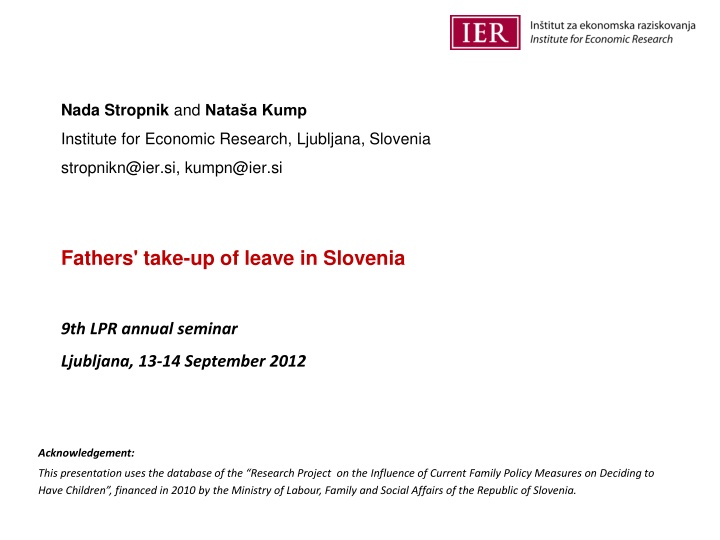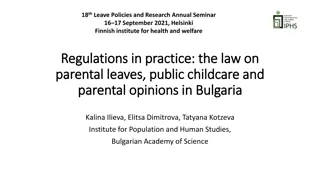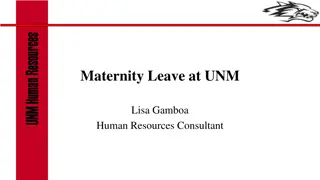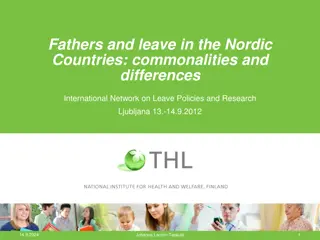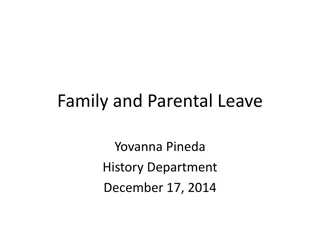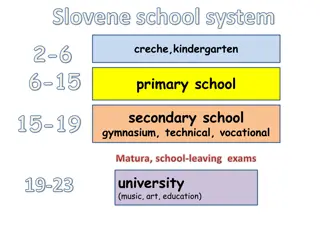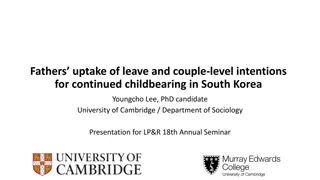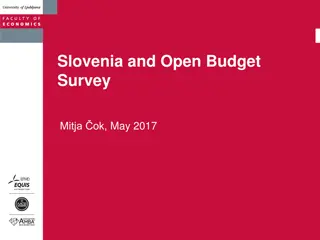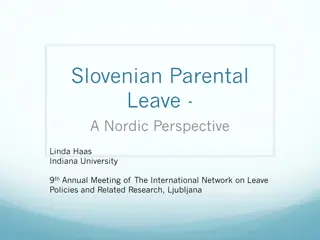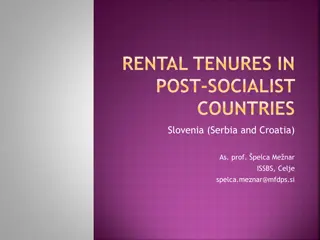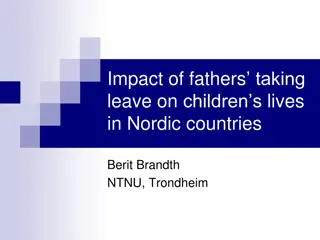Factors Influencing Fathers' Paternity Leave Usage in Slovenia
This study explores the factors affecting fathers' utilization of paternity leave in Slovenia based on a survey conducted in 2010. Factors such as child-related tasks, household work index, parental education, employment status, and settlement size were considered. Significant impacts on paternity leave uptake were observed in Slovenia, highlighting the importance of family policy measures in influencing fathers' decisions regarding parental leave.
Download Presentation

Please find below an Image/Link to download the presentation.
The content on the website is provided AS IS for your information and personal use only. It may not be sold, licensed, or shared on other websites without obtaining consent from the author.If you encounter any issues during the download, it is possible that the publisher has removed the file from their server.
You are allowed to download the files provided on this website for personal or commercial use, subject to the condition that they are used lawfully. All files are the property of their respective owners.
The content on the website is provided AS IS for your information and personal use only. It may not be sold, licensed, or shared on other websites without obtaining consent from the author.
E N D
Presentation Transcript
Nada Stropnik and Nataa Kump Institute for Economic Research, Ljubljana, Slovenia stropnikn@ier.si, kumpn@ier.si Fathers' take-up of leave in Slovenia 9th LPR annual seminar Ljubljana, 13-14 September 2012 Acknowledgement: This presentation uses the database of the Research Project on the Influence of Current Family Policy Measures on Deciding to Have Children , financed in 2010 by the Ministry of Labour, Family and Social Affairs of the Republic of Slovenia.
Research questions Which factors/characteristics increase the likelihood that fathers will take paternity leave? What are the reasons for not having taken more days of paternity leave?
Data Survey on the impact of family policy measures on deciding to have children Conducted in Slovenia in June 2010 Focused on gender issues and parental/paternity leave Computer supported telephone survey 1,013 persons aged 20-49 years (sample representative by sex/age, education, statistical region)
Determinants of the take-up of paternity leave Predictors Child birth order Child-related tasks index Household work index B SE B 0.231 2.54 2.169 OR 0.869 1.437 1.426 Marginal effect N -0.14 0.363 0.355 -0.02 0.052 0.05 25-29 30-34 35-39 40-49 45+ 20-24 25-29 30-34 35-39 40-49 Lower secondary or less Vocational secondary Higher secondary Post-secondary Lower secondary or less Vocational secondary Higher secondary Post-secondary Full-time employment Self-employment Not in employment Full-time employment Part time employment Self-employment Not in employment 1 34.78 96.13 41.53 31.23 22.43 14.04 77.26 81.74 44.40 8.65 -0.043 0.347 0.793 1.15 -0.502 0.711 0.836 0.928 1.237 1.037 0.958 1.415 2.21 3.159 0.605 -0.006 0.049 0.113 0.164 -0.071 Father's age at the time of birth of the youngest or only child 1 Mother s age at the time of birth of the youngest or only child -1.792 ** -2.508 ** 0.7 -0.084 0.197 0.231 0.618 0.816 1.525 0.479 0.954 0.301 0.167 0.081 2.015 0.919 1.218 1.26 -0.255 ** -0.357 ** 0.1 -0.012 0.028 0.033 Married 27.55 72.43 75.49 50.64 14.33 53.62 67.36 90.80 178.71 0.39 27.23 147.20 16.77 4.65 57.48 Father's education 1 -0.005 1.32 0.414 0.156 0.923 0.324 0.995 3.742 1.513 -0.001 0.188 0.059 Mother's education 1 0.101 0.137 1.106 0.014 1 -0.198 -1.529 0.678 0.808 0.82 0.217 -0.028 -0.217 Father's employment status 1 -0.129 -1.319 -1.012 * 0.755 1.199 0.51 0.879 0.267 0.363 -0.018 -0.188 -0.144 * Mother's employment status only or youngest child born in 2003-2005 -1.589 *** 0.455 0.204 -0.226 *** 500 inhabitants 500-7,000 inhabitants 7,000 inhabitants -2.001 ** -0.38 0.586 0.561 0.135 0.684 -0.285 *** -0.054 95.94 73.95 56.20 53.61 Settlement size 1 Grandmother in the same household Constant c2 df % of fathers who have taken paternal leave *p<.05. ** p<.01. ***p<.001. 1.055 3.752 65.01 27 75.2 0.622 2.873 0.15
Comments (1) Due to high take-up of paternity leave in Slovenia, significant impact on the likelihood that fathers will take that leave was found only for a couple of variables. Mothers aged 30-39 years at the birth of the youngest or only child are significantly less likely that those aged 25-29 years to have a partner who took parental leave. Only if the mother is not in employment, the father is significantly less (by 14%) likely to take paternity leave than if she is fully employed. It may be that these fathers do not feel any need to care for their own very young children since mothers are not employed, or that their employment/work characteristics do not permit or make it easy for them to take the leave. It is also probable that, with only one of the parents in employment, the couples (or men) do not want to risk the father s job if a negative employer s reaction is foreseen. Fathers who are not in employment are also less - though not significantly (p < 0.06) - likely than those in full employment to take paternity leave.
Comments (2) Taking paternity leave became more normal , expected, accepted and thus widespread in the period 2006-2010, that is, a year after its full implementation. The likelihood for fathers to take the leave in 2003-2005 was significantly (by 23%) lower. Obviously, it took fathers some time to get acquainted with their entitlement, find out what might be the co-workers and employer s reactions, and be able and ready to apply for it. As expected, fathers living in the smallest settlement category, i.e. settlements with less than 500 inhabitants, are significantly less (by 0.29 percentage points) likely to take the leave than those living in the largest settlement category, i.e. settlements with more than 7,000 inhabitants. This may be due to a lower "visibility" of individuals in large settlements, so men on leave are not that "exposed" in public as they are in smallest settlements. It may also be that men - and also women - living in largest settlements are more progressive in their attitudes and expectations regarding gender roles, and that there are more women with (high) professional aspirations, which requires higher father's involvement in care for the child.
Reasons for not having taken more days of paternity leave % of positive answers (N=211) I/he did not know about all provisions 14,0 I/he knew about the provisions, but did not seriously consider them 44,6 Financially we could not afford more unpaid leave 51,3 In my/his view, fathers can not be useful in the care of a small child 6,6 Co-workers, friends, acquaintances would make fun of me/him 1,2 Employer was not in favour of that. 27,1 Due to that I/he might have lost my/his job/work 12,7 I/he will use it later on 22,1 Due to the nature of my/his work, I/he does not need to (officially) take paternity leave 26,4
Comments (1) Two main reasons for not having taken more days of paternity leave were identified: 1) financially, the family could not afford more unpaid leave, and 2) the father did not seriously consider the provisions, although he knew about them. Starting with the 16th calendar day of the paternity leave the beneficiaries do not receive the compensation of their net salary. Not all families can afford 2.5 months without (one of the) earnings, but it also might be an excuse at hand for those fathers who, for various reasons - like uncertainty, feeling of not being able to care for a small child, etc. - do not dare or wish to stay at home with their child. Also, some may not consider themselves being in a position to do so due to the constraints related to workplace or employer, or unemployment risk and similar. The proportion of insufficiently informed fathers (14%) may seem quite high. However, all fathers who did not know about all provisions actually used 15 days of paid paternity leave. Fathers who knew about provisions but did not seriously consider them (almost 45%!), and those who share the view that fathers can not be useful in the care of a small child, do not really understand the purpose of the paternity leave and should be better informed about that, or even educated on the subject. Since 75 days of the paternity leave may be taken until the child s age of 3 years, there are about 22% of fathers who intended to use them later on. Over four out of five of these fathers have already used some of the paternity leave.
Comments (2) A very positive and surprising finding is that only about 1% of fathers did not take more days of paternity leave because of possible stigma, i.e. fear that co-workers, friend and/or acquaintances would make fun of them. This proves a general acceptability of the father s active role in taking care of the child. However, employers do have impact on take-up of paternity leave, particularly those in the private sector. If they are not in favour of their male employee s absence, fathers tend to deprive themselves - and indirectly their children as well - of that entitlement; about 27% of fathers in the sample acted so. This is a particularly sensitive issue during the economic recession or crisis, which we have been witnessing in Slovenia since 2009. About a fifth of fathers did not take more days of the paternity leave because of the risk of loosing their jobs (employees) or work (the self-employed). More than a quarter of fathers could combine work and family obligations without formally taking the leave. Interestingly, 85% of these fathers are full-time employees with obviously quite flexible work arrangements. A similar kind of reasons were given under "other": the father spends quite a lot of his time at home; due to flexible work or because of being self- employed he may occasionally take a day off without formally being on leave.
A non-answered question How many mothers were/are indeed willing to share (some of) the leave that is family entitlement with the child s father? This is particularly rarely probable in the countries where the whole of the mother's and family entitlement is less than about half a year. The same question was raised by Sundstrom and Duvander (2002) (and also brought out by Lappegard 2008) who argued that the father's parental leave is residual to the mother's. Consequently, the father is allowed or persuaded to use some leave when the mother chooses to return to work. This is the issue to investigate before we blame fathers for not taking parental leave.
Fathers are men, whose children have mothers (H jgaard, 2001)
